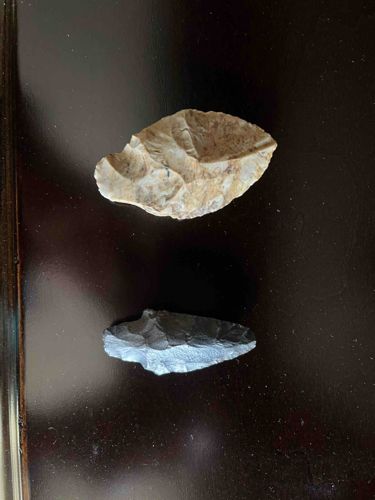
Prehistoric Stone Tools (Flint Knapped Scraper and Arrowhead/Projectile Point)
The image displays two distinct prehistoric lithic tools, likely crafted through flint knapping. The upper item appears to be a large scraper or hand axe, measuring approximately 2-3 inches in its longest dimension. It is made from a light tan or beige chert or flint, characterized by a somewhat rough, unpolished surface with visible conchoidal fractures indicative of percussion flaking. The edges show signs of intentional shaping, with some areas appearing sharper for cutting/scraping and others thicker for gripping or robustness. There are no discernible maker's marks or modern alterations. The color variations within the stone suggest its natural mineral composition. The overall condition shows a natural patina and some minor chips consistent with ancient use and age, but no apparent modern damage or repairs. The lower item is a smaller, more finely worked projectile point, often referred to as an arrowhead or spearhead. It measures approximately 1.5-2 inches in length and is crafted from a dark, possibly black or dark gray, glassy material, likely obsidian or a very fine-grained chert. This tool exhibits more refined pressure flaking, resulting in sharper edges and a more symmetrical, pointed shape. The base appears notched or slightly stemmed, suggesting it was designed for hafting onto a shaft. The surface is smoother than the larger tool, and there's a slight sheen visible, particularly on the lower left portion. Both pieces display craftsmanship typical of early human tool-making, demonstrating an understanding of how to fracture stone to create sharp implements. Their estimated age would be prehistoric, ranging from thousands to tens of thousands of years old, depending on regional archaeological contexts. The quality of craftsmanship for the smaller point is notably higher, indicating a specialized use such as hunting, while the larger piece likely served more general-purpose tasks.
AI-Generated Appraisal Disclaimer
Estimated Value
$100-300
Basic Information
Category
Archaeological Artifacts / Stone Tools
Appraised On
December 8, 2025
Estimated Value
$100-300
Item Description
The image displays two distinct prehistoric lithic tools, likely crafted through flint knapping. The upper item appears to be a large scraper or hand axe, measuring approximately 2-3 inches in its longest dimension. It is made from a light tan or beige chert or flint, characterized by a somewhat rough, unpolished surface with visible conchoidal fractures indicative of percussion flaking. The edges show signs of intentional shaping, with some areas appearing sharper for cutting/scraping and others thicker for gripping or robustness. There are no discernible maker's marks or modern alterations. The color variations within the stone suggest its natural mineral composition. The overall condition shows a natural patina and some minor chips consistent with ancient use and age, but no apparent modern damage or repairs. The lower item is a smaller, more finely worked projectile point, often referred to as an arrowhead or spearhead. It measures approximately 1.5-2 inches in length and is crafted from a dark, possibly black or dark gray, glassy material, likely obsidian or a very fine-grained chert. This tool exhibits more refined pressure flaking, resulting in sharper edges and a more symmetrical, pointed shape. The base appears notched or slightly stemmed, suggesting it was designed for hafting onto a shaft. The surface is smoother than the larger tool, and there's a slight sheen visible, particularly on the lower left portion. Both pieces display craftsmanship typical of early human tool-making, demonstrating an understanding of how to fracture stone to create sharp implements. Their estimated age would be prehistoric, ranging from thousands to tens of thousands of years old, depending on regional archaeological contexts. The quality of craftsmanship for the smaller point is notably higher, indicating a specialized use such as hunting, while the larger piece likely served more general-purpose tasks.
Related Tags
Explore similar items and categories:
Get Your Items Appraised
Instant estimates of your treasures with AI-powered instant appraisals